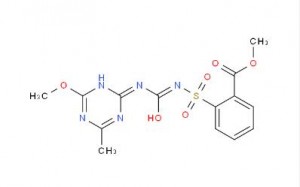Metsulfuron methyl, a highly effective wheat herbicide developed by DuPont in the early 1980s, belongs to sulfonamides and is low toxic to humans and animals. It is mainly used to control broadleaf weeds, and has good control effect on some gramineous weeds. It can effectively prevent and control weeds in wheat fields, such as Mainiang, Veronica, Fanzhou, Chaocai, shepherd’s purse, broken shepherd’s purse, Soniang Artemisia annua, Chenopodium album, Polygonum hydropiper, Oryza rubra, and Arachis hypogaea.
Related reading: Mode of Action of Metsulfuron Methyl
Its activity is 2-3 times that of chlorsulfuron methyl, and its main processing dosage form is dry suspension or wettable powder. However, due to its high activity, extensive weed killing, strong pertinence, and wide application in the world, it leaves a large number of residues in the soil, and its long-term residual effect will pose a threat to the aquatic ecological environment, so its registration has been gradually canceled in 2013 in China. At present, its use in China has been banned, but it is still widely used in the international market, and it can still hold export registration in China. The United States and Brazil are the top two export markets of methasulfuron methyl in China.
Related reading: Mixing Dicamba or 2,4-D with Metsulfuron Methyl
Physical and chemical properties
The technical drug is a white, odorless solid, with a melting point of 163 ~ 166 ℃ and a vapor pressure of 7.73 × 10-3 Pa/25 ℃. Water solubility varies with pH: 270 at pH 4.59, 1750 at pH 5.42, and 9500 mg/L at pH 6.11.
Related reading: 2, 4-D metsulfuron methyl or glyphosate: What’s the difference?
Toxicity
The toxicity to warm blooded animals is very low. The oral LD50 of rats is more than 5000 mg/kg, and the toxicity to aquatic animals is low. Its widespread use will leave a large number of residues in the soil, which will pose a threat to the aquatic ecological environment, such as reducing the cell density of Anabaena flosaquae, which has a significant inhibition on the acetyllactic acid synthase (ALS) of Anabaena flosaquae.
Action mechanism
Metsulfuron methyl is mainly used to control broad-leaved weeds in wheat fields, and can also control some gramineous weeds. It is mainly used for pre seedling soil treatment or post seedling stem and leaf spray. The main mechanism of action is that after being absorbed by plant tissues, it can quickly conduct up and down in the plant body, inhibit the activity of acetolactate synthase (ALS), prevent the biosynthesis of essential amino acids, inhibit cell division and growth, make seedlings green, growth point necrosis, leaf wilting, and then plant gradually withering, which is safe for wheat, barley, oats and other wheat crops.
Main compound
metsulfuron-methyl 0.27% + bensulfuron-methyl 0.68% + acetochlor 8.05% GG (Macrogranule)
metsulfuron-methyl 1.75% + bensulfuron-methyl 8.25% SP
metsulfuron-methyl 0.3% + fluroxypyr 13.7% EC
metsulfuron-methyl 25% + tribenuron-methyl 25%
metsulfuron-methyl 6.8% + thifensulfuron-methyl 68.2%
Synthetic process
It is prepared from its important intermediate, methyl phthalate benzene sulfonyl isocyanate (the same synthesis method as bensulfuron methyl), 2-amino-4-methyl-6-methoxy-triazine and dichloroethane, after reaction at room temperature, filtration and desolvation.
Major export countries
According to customs data, China’s exports of metsulfuron methyl in 2019 totaled about 26.73 million dollars, of which the United States was the largest target market of metsulfuron methyl, with total imports of 4.65 million dollars in 2019, Brazil was the second largest market, with imports of about 3.51 million dollars in 2019, Malaysia was the third largest market, and imports of 3.37 million dollars in 2019. Indonesia, Colombia, Australia, New Zealand, India, Argentina and other countries are also important importers of methyl sulfuron.
Post time: Jan-09-2023









